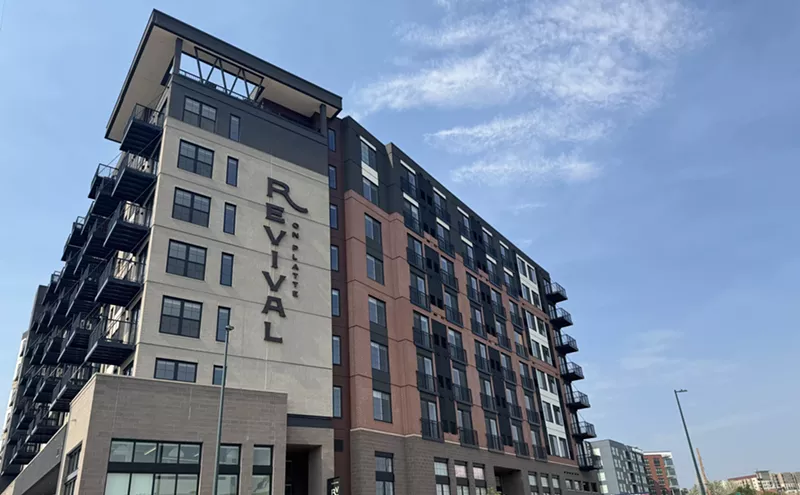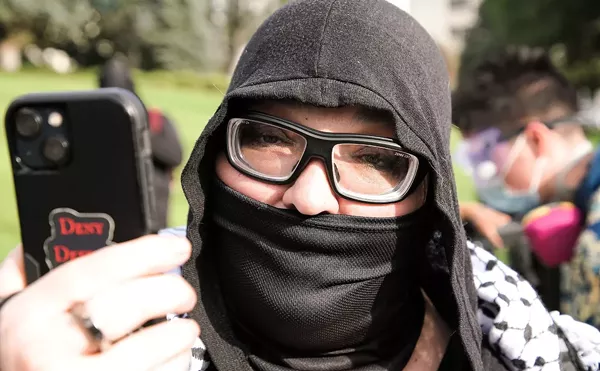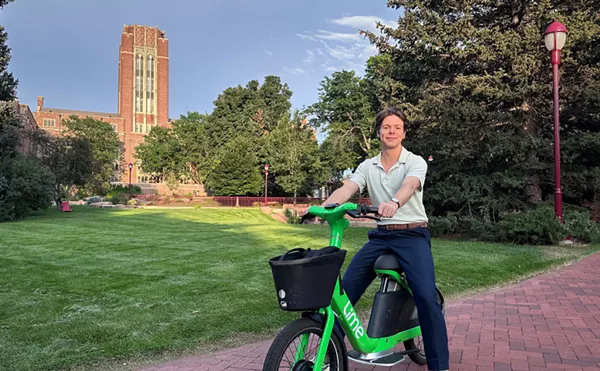“Don’t get out of the car unless we say so.” Those were the cop’s orders to Rebecca Meyers, a Jefferson County child-welfare caseworker who was waiting to make a home visit. From the driver’s seat of her car, she watched as at least a half-dozen officers went up the street from where she was parked to enter the home and sweep it for illegal firearms.
Rebecca wondered how things had gotten to this point. As a caseworker, part of her job was to visit homes and assess whether child abuse or neglect was occurring. Usually this was done without law enforcement officers, as a police presence could cause a home’s occupants to distrust her. But this night, Rebecca had a whole squad of officers in tow, and she was grateful. That’s because a man living inside the house was a known felon with a history of gun charges.
Out of the darkness, an officer approached her car. “It’s all fine; you can come in,” the officer said. Rebecca gulped, feeling her heart beating against her chest. Now she had to go inside the house and inform the family that they’d been reported for abusing or neglecting their child. She’d ask the guardians a few questions and look at the child to see if there were any signs of bruises or malnutrition. But even though the police hadn’t located any weapons, she was now so nervous about talking to them that she could barely concentrate. She knew she had an important job to do, but all she could think about was getting out of there.
Worse, this call was just one out of ten or so that she had to tackle in the next week, each as unpredictable as the next.
The family ended up being cooperative that night, but the difficulty and danger of Rebecca’s job eventually took a toll on her, and she left the Jefferson County Human Services Department in 2011.
As it turns out, she wasn’t alone in experiencing fear and anxiety as a child-welfare caseworker. Three years later, after finishing graduate school, Rebecca helped organize the Alliance of Child Welfare Caseworkers, or the Alliance for short, with the goal of sharing stories and suggestions about how caseworkers throughout Colorado could be better supported.
Between October 2014 and September 2015, state child-welfare departments received 88,514 reports of child abuse or neglect, 32,706 of which were taken on. But a recent report released by the State revealed that Colorado counties would need to hire more than 700 additional employees — a stunning number — in order to properly handle the active cases.
There are other issues affecting caseworkers beyond understaffing, however. Beginning in 2013, the Alliance began meeting in secret to formulate questions for focus groups of caseworkers across the state, with the goal of presenting the results of their survey to lawmakers. The group met at the homes of Alliance members and sometimes in the offices of the local chapter of the National Association of Social Workers (NASW), which was helping the Alliance prepare materials for the focus groups.
Rebecca wondered how many caseworkers would eventually come forward. There was a fear of speaking out against the system, of potentially losing jobs or being held liable after acknowledging mistakes in the handling of cases. Most of the Alliance members who helped prepare questions for the focus groups had already left their caseworker jobs or were just about to. Although some were leaving for strictly personal reasons, many of their stories were similar. All believed that Colorado and its counties could do a better job of supporting child-welfare workers.
Besides Rebecca, there was Jessica Reilly, who was dismissed from her position in Denver after voicing disapproval of a newly appointed supervisor over how he handled death threats that a woman had been leaving on Jessica’s phone.
Another woman, Emily (whose name has been changed at her request to protect her from potential liability issues associated with cases she worked on) was already on her way out of child welfare when she joined the group. Her concerns had to do with how mentally and physically unhealthy many of her co-workers in Adams County were — how they felt like they couldn’t ask for help with their caseloads because of the guilt of burdening others with extra work. When she started, she says, a supervisor told her, “You’ll only be able to do 60 percent of the job.”
Stephanie Brinks was also a participant, having left El Paso County for mental-health reasons and because she was tired of the low perception of caseworkers — not just by the public, but also by judges and public defenders who downplayed her credibility in court cases, even though, of everyone involved, she’d spent the most time with the families in question.
Later, the Alliance came to learn of others, like Autumn (whose name has also been changed), who left her job with Adams County after eight years, exhausted by what she felt were unnecessary administrative tasks and disappointed by mandatory training that left her feeling neither prepared nor inspired.
None of the women had come into the job disillusioned, nor had they chosen child welfare as a career because they thought they would make a lot of money. (Nationwide, the average salary for a child-welfare caseworker is in the low to mid-thirty thousands; salaries in Colorado vary by county and range from the low thirty thousands to the mid-forty thousands.) Rather, they’d picked their jobs because they wanted to help children and families stay together, and they wanted to be able to give them the tools, resources and support they needed to lead healthy lives.
There are roughly 1,200 child-welfare caseworkers in Colorado, many of them young women recently out of college. (The state doesn’t have statistics on gender, but members of the Alliance say that women made up close to 90 percent of the staff in their county departments.) The majority sign on because they believe in the importance of social work and feel that struggling families deserve a chance to do better.
Despite their good intentions, however, too many find themselves unable to stay in the profession for long. In some Colorado counties, the annual turnover rate approaches 25 percent, according to the state auditor’s report.
A review of more than a dozen national studies shows that across the country, turnover rates in the field average between 25 and 60 percent. This revolving-door situation plagues child-welfare departments, because it’s expensive to constantly recruit and train new employees. But beyond draining taxpayer money, it forces families in the system to adapt to a new caseworker every time an existing one quits, often leading to inconsistency and poor case outcomes. A successful case requires a collaborative relationship between families and caseworkers, a delicate dynamic built on trust and time.
There are a host of issues at the root of low caseworker retention rates, but efforts to address them in Colorado have been slow or sporadic. One reason for the sluggishness is that child-welfare systems tend to attract the attention of the public — and legislators — only when the news is bad (child fatalities, cases of gross neglect, etc.). In 2007, the state experienced a series of well-publicized child deaths, including that of seven-year-old Chandler Grafner, who was locked inside a closet by his foster parents until he died, surrounded by his own excrement. The frenzy around that horrific case and others caused then-governor Bill Ritter to assemble a committee that submitted 34 recommendations for changes in child-welfare law and policy. Of the recommendations that were subsequently implemented, the most significant was the creation of a mandatory caseworker-training academy in Douglas County.
More recently, a 27-year-old caseworker in Denver County named Rotchana Madera pleaded guilty to falsifying records in the case of a two-month-old girl who was fatally beaten. Madera received two years’ supervised probation, but the case also led to a review by the state of how Denver County caseworkers conduct family background checks.
Because of the way in which Colorado’s child-welfare departments are set up, caseworkers’ experiences in the state are not uniform. Ours is one of nine states with a state-supervised, county-administered child-welfare system, which means that each of the state’s 64 counties has its own child-protection service. But many of the problems affecting caseworkers cross county lines.
According to the Alliance, caseworkers are often left to struggle silently, without enough support or supervision and lacking clear-cut policies — which is why the group has identified common areas for improvement, places where they say lawmakers and child-welfare administrators can focus more attention and resources. These include training, mental health, perceptions of caseworkers, supervisor support, and workload/administration — all concerns for which members of the Alliance have stories to share.
The Alliance is now working with lawmakers to see about the possibility of creating a bill during this year’s legislative session to address some of these issues.
Training"Child welfare was one of those things that had a terrible reputation.”
tweet this
Emily was still with Adams County Children and Family Services when she joined the Alliance. She later quit that job to become a therapist, the profession she still practices.
Like many others, Emily hadn’t planned to become a child-welfare caseworker. After graduating from Colorado State University with a master’s degree in social work, she went to work for a nonprofit child-placement agency. “Child welfare was one of those things that had a terrible reputation. People would say, ‘Oh, that’s so hard, you don’t want to do that,’” she recalls.
But while working at the child-placement agency, Emily came to appreciate the power that county caseworkers seemed to have in directing children’s lives — influencing where they lived and how they grew up and whether they’d ultimately turn out okay. She saw the potential to do a lot of good, and although she knew that the job would be tough, she yearned for that power and for the challenge of picking up the pieces of a broken family. So in early 2012 she made the jump, taking a caseworker job with Adams County.
With her degree, Emily was actually more qualified than most. She had already received field training in social work through three semesters’ worth of internships. One requirement of both undergraduate and graduate social-work degrees is field experience, which is why organizations like the NASW lobby states and counties to hire more degreed individuals. The programs also provide graduates with a background in social-work policy and an educational grounding in areas such as child development.
“The public thinks that everyone who does child-welfare work is a professional social worker, but in reality, it’s less than 40 percent,” says Joan Levy Zlotnik, a Washington, D.C.-based consultant for the NASW and a social worker who has been researching child-welfare workforce issues for more than twenty years. “Of that, the majority have a bachelor’s in social work, and fewer have a master’s,” she adds, citing a study from the National Survey of Child and Adolescent Well-Being, which was compiled between 1997 and 2014.
Zlotnik notes that hiring caseworkers with a BSW or MSW has been found to increase retention, therefore reducing turnover and costs. According to a national study by the Institute for the Advancement of Social Work Research, 80 percent of caseworkers who stayed on the job for more than two years had at least one social-work degree.
As is the case in many other states, county departments in Colorado don’t require caseworkers to have social-work degrees, but the state has stepped up other requirements and training, such as those that were enacted following the high-profile child fatalities of the late 2000s. Included in that group is the mandatory Child Welfare Training Academy, which Emily attended in 2012. Stephanie and Autumn, who both started their jobs prior to the academy’s 2010 opening, say that they were given cases before they had had any classroom instruction.
Emily says that the academy had qualified teachers who treated her well, and that she was provided with breakfast every morning and gas money. But she also believes that her seven weeks there were a far cry from the reality of being a caseworker. Although it was helpful to review theories on child development and ways to determine if child abuse or neglect was occurring in a home, the academy didn’t include adequate instruction for the specific procedures, forms or documents that she would need to use when working with families in Adams County.
Over the past two years, the state has begun to rectify this situation by contracting its training out to the Kempe Center at the University of Colorado Denver and by splitting the single academy into four separate regional academies more tailored to their surrounding counties. But with 64 counties in Colorado, there are procedural variations that the training facilities still do not cover.
Despite feeling unprepared, Emily believes that she had a positive impact on families, with few of her cases resulting in the permanent removal of a child. During her time at Adams County, she would try to help new hires, telling them that they couldn’t always predict how their cases would turn out, despite their best intentions.
“Every one of them has their heart in the right place. They do the best they can,” she says of her former co-workers.
Emily left Adams County in 2014, after two and a half years there.
Mental Health"The public thinks that everyone who does child-welfare work is a professional social worker, but in reality it’s less than 40 percent.”
tweet this
Another topic of concern for the Alliance is caseworker mental health. Rebecca Meyers is all too familiar with the issue, and not just because of the night the police swept the house in Jefferson County for guns.
Rebecca began her career at the age of 23 in Oregon, where she worked for two years before moving to Colorado, and she vividly remembers her first day on the job: She and another caseworker were heading to a home visit when the other woman asked Rebecca if she’d heard about a caseworker in Washington state who’d recently been attacked with an ax by someone on meth.
The story chilled Rebecca to her core. It was impossible to predict how home visits would go, and fear soon became a regular part of her life. Each time she was subjected to a traumatic episode — an angry father who punched a hole in the wall next to her head in a courthouse; a woman beaten so badly by her husband that she could no longer form coherent sentences; a child in the hospital, screaming from the pain of broken ribs — she could feel the effects. She started experiencing panic attacks whenever her beeper went off, not knowing if a house call would end up like 80 percent of her cases, where things went relatively smoothly, or if it would be one of the 20 percent of cases she’d come to expect, when “shit went nuts.”
In Oregon, at least, she had a sympathetic supervisor who would allow her to cry in her office. Rebecca said that she and her co-workers would exchange stories and joke that they’d developed a “trauma bond” based on some of the unbelievable things they were seeing — most of which they couldn’t share with family members because of confidentiality laws, or just because they didn’t want to relive the moments.
“It’s not like you can come home at dinner and talk about how a child was describing having a finger put in her vagina,” says Rebecca. “It’s just not really dinner conversation.”
Rebecca decided to quit her job in Oregon one morning in 2006, when she arrived at her office and found three domestic-violence cases sitting on her desk, all of which needed to be dealt with immediately. She flipped through the reports. “Well, it looks he only hit her once in this one, so she’s probably okay to wait until tomorrow,” Rebecca remembers thinking. And that’s when she felt sick. “There was this woman who had been abused, and I just wrote it off because it wasn’t bad enough,” she says.
But three years later, after moving to Colorado with her husband, Rebecca needed a job and found herself taking one as a caseworker in Jeffco. She hoped that she would be able to better cope with the demands of child welfare here. She was surprised by how quickly the panic attacks returned.
Rebecca also experienced serious trauma: During a six-week period, four children on her caseload died, all of them under four months old. Two of the deaths were ruled accidental and two were deemed murders — one by intentional neglect, the other by physical force.
It was highly unusual, and even though Rebecca wasn’t blamed, she had a mental breakdown. She could barely eat. She began losing weight and couldn’t drive. In nightmares, she’d see the babies’ faces, or sometimes imagine their parents attacking her with sharp objects or locking her in a box. She was ordered to see a Colorado Department of Human Services psychologist, but then was never given options for continued therapy. Trying to stay on the job, she started paying out of pocket for her own therapy, scheduling visits to fit around her casework. Sometimes she’d get billed for sessions that she had to leave because of emergency intake calls.
In Colorado, there has been a push recently for workers’ compensation to be made available to police officers who suffer secondary trauma and PTSD. Rebecca was also diagnosed with PTSD, but there is currently no movement to make compensation available for caseworkers.
Jonathan Singer, state representative for District 11, in Longmont, used to be an intake caseworker for Boulder County. Singer helped sponsor a bill for the police officers’ workers’ comp in 2014; he agrees that the mental health of child-welfare caseworkers is something that county administrators need to support and provide more funding for in Colorado. “Vicarious trauma is a huge issue,” he says. “Reading reports on a day-to-day basis about kids who’ve been abused or violated — if that doesn’t have an effect on you, you probably shouldn’t be in the profession in the first place.”
Jefferson County Deputy Director of Human Services Lynnae Flora says that the county recognizes the mental-health needs of its workforce. “This is highly important, not only to Jefferson County, but other counties as well,” says Flora. “Certainly, we’ve got two main customers, and our internal customers are our staff.”
Like most Colorado counties, Jeffco offers employee assistance programs, but these only cover a limited number of therapy sessions. As a result, some counties, including Denver, say they have taken extra steps to address trauma in supplemental training regimens and are working with supervisors to identify trauma in their caseworkers.
For Rebecca, the stress meant that she wasn’t able to make clear decisions and often became paralyzed with anxiety — not a good situation for someone who is making potential life-and-death decisions. She was also panicked and upset during many of her home visits, and concerned that that could lead to administrative mistakes when completing documentation later on.
To this day, Rebecca says, she can’t drive past certain places in Golden and Westminster without having violent flashbacks to things that occurred there.
After a year and a half with Jeffco, she had to quit. But she didn’t abandon social work altogether, instead enrolling at the University of Denver to get her MSW. “I went to grad school because I wanted to understand why we couldn’t do more — why we didn’t have more resources at our disposal, and why we needed to follow protocols that made no sense,” Rebecca says.
After helping run the Alliance in 2013 and 2014, she is now a contract lobbyist for Frontline Public Affairs, which is hired by organizations like the NASW to present positions on legislation.
Perceptions of Caseworkers
Another common experience cited by caseworkers in the Alliance is feeling misunderstood by the media and the public.
Like Rebecca, Stephanie Brinks, who worked for El Paso County’s Department of Human Services for four years and in Denver for a two-month stint in 2013, had her worldview permanently altered during her time as a caseworker. “I feel like I am not the same person I was before I started this job” at age 22, she says. “I used to be really confident in my employment and decisions I made, and now I have anxiety. I get stuck and can’t make the simplest decisions at work sometimes.”
A therapist diagnosed Stephanie with an anxiety disorder, based partly on the fact that she had to make such weighty decisions all the time concerning her cases. She mostly worked with teenagers, and the hardest decision was whether to separate them from their parents, something that happens only after all other options have been exhausted.
Yet despite estimating that she terminated parents’ rights in only about 10 percent of her cases, and only under the most drastic circumstances, Stephanie says that it’s all too common for caseworkers to be seen by the public as “child snatchers.”
“It was like I was hated by everyone — the families I worked with, the general public.... I would really like to see that change,” she says. Firefighters and child-welfare workers are both first responders who go into dangerous situations and try to help, she adds, “except firefighters are the ones seen as heroes.”
Caseworkers use various strategies to mitigate and deal with negative perceptions by the public, including developing a thick skin, not revealing what they do for a living, and trying to explain how their jobs really work. But working within the judicial system is a whole other matter. Stephanie says it was common for El Paso County judges, attorneys and guardians ad litem (court-appointed attorneys for children) to ignore her recommendations for children in court proceedings, and others in the Alliance say they have experienced the same type of thing.
“It was frustrating, because I felt like, as the caseworker, I knew the family the best out of all the service providers,” Stephanie says. “But instead, the court magistrates would listen to the guardians ad litem or other attorneys.”
Stephanie claims that one GAL she dealt with regularly barely knew about the children on her caseload, yet his opinions were the ones that affected court decisions. She tried to file an anonymous complaint with El Paso County but was approached by her managers at the county’s department of human services, who worried that the GAL might charge the county with slander based on Stephanie’s statements.
“I’d made that complaint because the GAL wasn’t listening to the kids and was making things worse for families,” says Stephanie. “And instead, DHS was worried about slander.”
El Paso County DHS spokeswoman Kristina Iodice says her department isn’t aware of any broad problems with its caseworkers being respected in court. “We have a very open, very honest and very strong working relationship with the courts and with all the parties involved with our child-welfare cases. That being said, we’re not afraid to push back if our caseworkers disagree with what’s being presented.”
But Stephanie says she couldn’t last as a caseworker while feeling so undervalued for the work she was doing. She worked for El Paso County until one weekend when she had such severe panic attacks regarding her cases that she couldn’t get up off the floor. Her husband begged her to go to the hospital and eventually took her to urgent care. Stephanie was unable to eat and by Sunday had lost several pounds.
“The Monday after that weekend, I handed in my resignation,” she says.
Supervisor Support"I was trying to help families be better families, so I wasn’t going to deprive my own family of me.”
tweet this
With so many pressures at work, caseworkers need supportive and competent supervisors. The Child Welfare League of America, an advocacy group, recommends a ratio of five caseworkers to each supervisor. Statewide, the average is 5.6 caseworkers to each supervisor, according to a 2014 audit funded by the Colorado Department of Human Services. Officials in larger counties such as Denver say they’re working to reach the CWLA’s target.
Of course, the quality of supervisors varies, as Jessica Reilly explained to the Alliance while recounting a personal experience. Jessica worked as a caseworker from 2002 to 2004 in San Diego, and again from 2011 to 2013 in Denver. While in Denver, she says, she experienced both a good and a bad supervisor on the very same case.
The situation involved a mother and four children who were on Jessica’s caseload; according to caseworker guidelines, she had to interview each of them individually. The mother was mentally unstable and prone to making violent threats. It was hard for Jessica to predict when she’d be cooperative during visits.
The first death threat Jessica received was in December 2012, when the mother told her over the phone, “I got someone coming after you. You need to watch your back.”
Spooked, Jessica informed her supervisor, who was also alarmed by the threat and offered Jessica protection and an extra caseworker to join her on the case, asking to be kept informed of any further developments. “Do you need security to walk you out to your car?” the supervisor asked.
Jessica was relieved to know that her boss had her back. But when a new supervisor — a former co-worker of Jessica’s — took over, things changed. After she received two more threats, Jessica told her new boss, who only said, “Thanks for letting me know.”
Jessica thought the response was callous, and she began raising concerns about the new supervisor to other people in the office. She was dismissed from her job soon afterward.
Jeff Holliday, Denver’s deputy manager of child protection and prevention, says he can’t comment on personnel issues, but generally speaking, he says, “Every caseworker has both the authority and responsibility if they’re in a situation like that to escalate that situation up — if it requires — all the way up to Don [Mares, Denver Department of Human Services director]. We want to know about those things, because it wouldn’t be okay for us to put anyone in a situation like that.”
Denver can also assign police officers to protect caseworkers who receive threats, he adds. Another option is requiring that a family meet with the caseworker in a supervised setting, such as the DHS offices.
Workload/Administration
A final significant hurdle for caseworkers is time management. While it’s natural to focus on the drama of home visits and interviews with children and families, the majority of a caseworker’s time is spent in writing and documentation. A 2011 national study by the American Humane Association found that on average, only 18 percent of caseworkers’ time was spent in direct, face-to-face contact with children and families. The rest was largely administrative, or was time spent driving between visits.
As such, a significant contributor to burnout and low retention rates is the sheer amount of paper that caseworkers have to push — the unceasing, overwhelming crush of writing and filing they must do in order to properly document their caseloads, which the Child Welfare League of America believes should never climb above twelve to seventeen children per worker.
A 2007 national study by the Children’s Defense Fund found that only 11 percent of child-welfare departments in the United States at the time met the CWLA’s caseload standards. Anecdotally, the Alliance found that while caseloads in Colorado vary from county to county, only rarely do they meet those numbers.
All of the paperwork tied to cases has a purpose, of course: to inform court decisions and to protect both families and caseworkers by keeping a detailed record of their interactions. But the workload is largely what wore Autumn down after eight years of working in Adams County.
She remembers that in her first weeks on the job there, a co-worker asked, “Have you figured out what your job is as a caseworker yet?”
“Um, no,” Autumn responded.
“Well,” said the co-worker, “basically, you stand with your hands open and your mouth wide and you look up, and above you there’s this huge vat of shit. And its got these tubes so it’s coming out from all different angles — the court, your own office, GALs, foster care, kids, parents — and your job is to just catch it all. Your job is to get that shit from all angles.”
In 2014, the Colorado Department of Human Services funded a workload study of child-welfare caseworkers that found that the state needed an additional 574 caseworkers and 144 supervisors to properly cover their caseloads. The study also said that at 2014 staffing levels, caseworkers needed as much as 157 percent more time to properly carry existing workloads.
“I had to put up boundaries for myself and my family; that’s how I survived,” Autumn says. This began after she got married three years into the job. “I was trying to help families be better families, so I wasn’t going to deprive my own family of me and not make my family good because I was helping others.”
It was a constant tug-of-war between Autumn’s own family and the ones she was helping. And although she felt bad about burdening her already overburdened co-workers with extra cases during a maternity leave and a month-long honeymoon, those breaks were the only thing that kept her from burning out sooner.
Looking back on her eight years at Adams County, Autumn says that things did get better over time. When she started, some caseworkers had 25 families on their caseloads (which also means that they were responsible for working individually with each family member involved in a particular case). That number was partly due to high turnover rates of caseworkers at the time, with the remaining staff having to assume cases from those who left. But the caseload steadily decreased to an average of eleven families per caseworker.
This was partly because of an increase in staff, but also because of some commonsense restructuring by Adams County, Autumn says.
For instance, there used to be a night team of five caseworkers who would stay in the office and field calls overnight. Then management dismantled the team and created a mobile response unit that could stay home and answer calls using cell phones, offering the positions on a volunteer basis to caseworkers who wanted extra hours and pay. The dismantled night team added an extra caseworker to each of five daytime teams, which helped spread out the work.
Despite the stress and the problems, all of the women who met in the Alliance still believe strongly in the child-welfare system — that it’s necessary to help families and children obtain services like therapy, rehab, food vouchers, transportation and job assistance.
For Rebecca, it was the positive outcomes on her caseload that kept her going. This included a 23-year-old meth-addicted mother with whom she worked in Oregon. Rebecca would converse with her by phone late into the night or sit with her in hotel rooms and talk her down from her desire to use drugs again. The young mother had been physically abused growing up, tied to a table by her grandparents whenever they left the house. It was a complicated case, but Rebecca’s rapport with the mother helped her get into treatment and eventually regain custody of her six-month-old daughter.
On Rebecca’s last day in Oregon, the mother called Rebecca to thank her. “I’ll never forget the phone call,” Rebecca says. “She said she’d be dead if it wasn’t for me.”
“Those are the moments you live for,” she says. “That’s why you do the job. They don’t happen every day; sometimes they’re few and far between. But when they do, when you feel run down and overwhelmed and emotionally exhausted and you feel like you can’t give anything else to anyone, those are the moments that pull you back in. And that’s why I believe so many people like myself stay. Because if it can happen in that scenario, why can’t it happen again?”
Autumn tells a similar story. “Most of [the families], you really wonder what you’d do if you had their life. They’re good people trying to do their best, and they don’t know because they haven’t been given the tools. They love their children and their children love them, and so I told every family: ‘My number-one goal is to get your child back. What’s in the best interest of the child is to be with you in a healthy home.’”
After six months of preparing questions, the Alliance was able to get dozens of caseworkers from throughout Colorado to attend their focus groups in 2014 and 2015. Most participants were reached through word of mouth, and all were offered anonymity to share their experiences and suggestions for improvement in the child-welfare realm.
“They had great ideas,” Rebecca says. The groups’ suggestions included more hires, having in-house psychologists in county departments to care for caseworkers’ mental health, requiring supervisors to be former caseworkers and to know county services intimately, and the opportunity for caseworkers to cycle among various child-welfare positions to avoid burnout.
Mostly, though, the caseworkers felt that they needed a voice and the ability to air grievances in the workplace without fear of retaliation.
One of the suggestions has already seen some action: After the Department of Human Services workload study was released in late 2014, the state Joint Budget Committee approved funding to hire 100 additional caseworkers out of the recommended 574 during 2015. The DHS says that 100 more will be hired and trained in 2016.
State senator Linda Newell, who pushed for the study along with former state representative Jenise May and Representative Singer, says that the 200 additional caseworkers are “still a fraction of what we actually need.” Ultimately, more caseworkers will mean lower caseloads and better outcomes for children and families.“There are always widgets to be made, there's always sugar water to be produced — but these people are dealing with children's lives."
tweet this
“From the caseworkers’ perspective, these are people who are stepping up to a very hard job, at low pay, and with lots of stress and responsibility. They’re just trying to do the right thing. We should be doing everything we can to support them,” says Newell.
One of the ways that Newell and Singer have already supported caseworkers was by securing state funding for an independent Office of the Child Protection Ombudsman, which reviews complaints from families affected by the system as well as internal child-welfare staff.
And counties are tackling some of the issues raised by the Alliance on their own. After receiving only eight of the state’s 100 new caseworker hires last year, Denver allocated its own money from Mayor Hancock’s 2016 budget for 51 new caseworkers, staff and aides. “We’re doing all we can to make sure we don’t have turnover, and [we’re] giving people as much support as we can,” says Human Services director Mares.
Some other efforts are being made at the state level to try out new screening and outreach models in child welfare. One ongoing experiment in Colorado is an approach called differential response. The idea is to allow caseworkers more flexibility in how they respond to families rather than having them follow rigid investigative models, leading to more collaboration between the two.
Fifteen counties are participating in the program, according to the Colorado Department of Human Services. Robert Werthwein, director of the Office of Children, Youth and Families, says, “We provide technical assistance as well as resources needed for every county that wants to come online [for differential response]. We are 100 percent behind the counties that want to come on. We don’t force anybody into a system they feel doesn’t work for them, though.”
That’s a step in the right direction, says Renee Rivera, executive director of the Colorado chapter of the NASW, who believes that creating a sustainable and empowered workforce of caseworkers involves listening to their needs, identifying problems through efforts like the Alliance, and taking those findings before lawmakers. It also takes buy-in from the public, which all too often focuses on how children and families are being failed but doesn’t necessarily acknowledge the caseworkers who are there to help them.
As a social worker herself, Rivera worries that some lawmakers holding the purse strings in Colorado don’t fully understand the important roles that caseworkers play. “There are always widgets to be made, there’s always sugar water to be produced — but these people are dealing with children’s lives,” she says.
While the Alliance has finished conducting focus groups for now, it still exists as a committee within the NASW, and met as recently as December to discuss legislative agendas for 2016.
The Alliance’s findings would have to be expanded before they could be released to the public, Rivera says. But Alliance members have been sharing the data with specific legislators to see if they will sponsor a bill this session. The bill would address such things as caseworker safety and mental health.
Rivera wouldn’t comment on which legislators the Alliance is talking with, but she says the group will continue meeting regardless of whether they are able to get lawmakers to take up the cause this particular session.
In the meantime, Rebecca still marvels at the bravery of those who came forward and told their stories. Their experiences reinforced something she had to learn the hard way: “Nobody knows what it’s like to have the responsibility of a child-welfare caseworker unless you’ve done it.”












